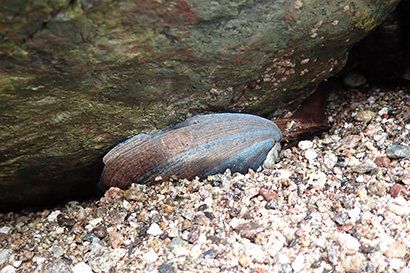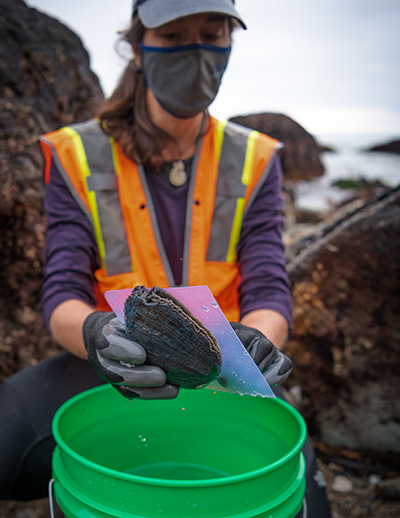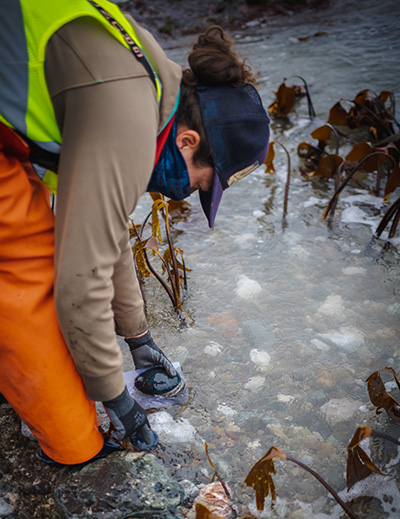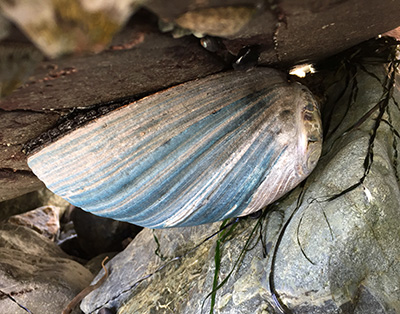The Big Sur coast is prime habitat for black abalone and has had one of the few remaining healthy populations of this endangered species. So when heavy winter rains triggered debris flows from the Dolan Fire burn scar, dumping tons of sediment onto the coastline, marine scientists at UC Santa Cruz found themselves leading a rescue operation.
Since early February, they have been digging out buried abalone, packing them in coolers, and taking them to a rehabilitation facility. Hundreds of abalone have been saved, but thousands were lost. The impact of these events on the overall population remains to be determined, said Peter Raimondi, professor of ecology and evolutionary biology at UC Santa Cruz, who is supervising the operation.
“It could be catastrophic, because the bulk of the healthy black abalone population was in Big Sur,” Raimondi said. “We have thought of that area as a reservoir for potentially reestablishing black abalone in new areas, but if enough of them have been lost it will really compromise the ability of that population to grow.”
Raimondi said he began to worry about the potential impacts of debris flows on the abalone well before the winter rains came. Several major fires in the coastal ranges—the Dolan, Carmel, and River Fires in Monterey County, and the CZU Lightning Complex north of Santa Cruz—burned watersheds that drain to critical areas of the coast for black abalone.
“When I looked at the maps of the fires, and Cal Fire and Cal Trans started putting out maps of potential debris flows, I could see they were aligned with where most of the remaining healthy populations of black abalone were,” Raimondi said.
UCSC graduate student Wendy Bragg, who has been leading the rescue efforts in the field, said previous surveys of the black abalone population on the Big Sur coast enabled the researchers to identify places to focus their attention. Although she expected to see impacts, what she saw the first day was still a surprise.
“Some sites were impacted more than others, but where it was most severe it took us some time to reorient ourselves, because of the dramatic changes to the coastline,” Bragg said. “In some locations, we would notice the smell of things rotting before we even got there to start looking around.”
The debris flows were triggered by an “atmospheric river” event in January that dumped 15 inches of rain in three days on the Big Sur coast. A section of Highway 1 was washed out at Rat Creek, and a massive debris flow swept through the Landels-Hill Big Creek Natural Reserve.
“It was just one rain event, but the amount of sediment that came down is huge,” Raimondi said.
Bragg said the team has mostly paused its rescue efforts for now, after two months of responding to new emergencies as shifting sediments affected sites that were not hit by the initial debris flows. The researchers are now working to identify suitable areas where they can safely return the roughly 200 black abalone that were rescued. The researchers will also continue to monitor the coastline while they begin to assess the overall impact on the black abalone population.
“The Big Sur coast is pretty inaccessible, so there are areas we haven’t seen yet,” Raimondi said. “We plan to start flying drones along the coast to assess those other areas, but at the sites we’ve been able to get to, the impacts are massive.”
Bragg estimated that in the areas they have been able to access, the losses of abalone are in the thousands. “If we extrapolate that to the whole area, it’s potentially tens of thousands, so the losses to the species overall could be catastrophic.”
The black abalone population has already been hit hard by a disease known as withering syndrome, which caused mass mortalities in Southern California and has progressed up the coast as far as the southern end of Big Sur. That’s why the healthy population on the Big Sur coast is so important.
“It’s not that black abalone will go extinct on the Big Sur coast because of this. It’s just that they will now have to recover locally before the population can spread and repopulate other areas,” Raimondi said.
Raimondi leads the Multi-Agency Rocky Intertidal Network (MARINe), a consortium of organizations conducting long-term monitoring and biodiversity surveys along the Pacific Coast of North America. His team at UCSC includes a large number of scientists with expertise in coastal field surveys who were able to quickly shift to the abalone rescue operation. The UCSC team worked closely with state and federal agencies, including the National Marine Fisheries Service (NMFS), California Department of Fish and Wildlife (CDFW), and Monterey Bay National Marine Sanctuary (MBNMS).
“NMFS and CDFW were both very responsive in terms of permits and providing support, and we also got a lot of help from local landowners and volunteers in Big Sur,” Raimondi said.
The threat of additional debris flows and landslides is likely to continue for several years, because the fires have destabilized the soil over large areas of the coastal mountains.
“Cal Fire is telling us most of the debris is still up there, so a bunch more could come down,” Raimondi said. “There’s also a huge amount of sediment offshore now, and we’re not sure what’s going to happen with that. Normally, the sand moves offshore in winter and comes back onto the beaches starting around May, so we’ll keep monitoring and be ready to respond if we need to.”
He noted that climate change is increasing the frequency and severity of both wildfires and large storms, and their effects highlight the linkages between land and sea along the coast. “We haven’t seen something like this since I’ve been here,” he said. “These massive winter storms coming after a fire can cause havoc in the ocean.”






